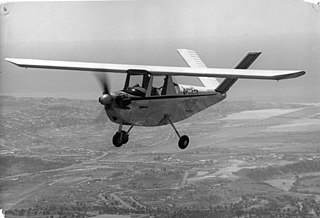
The Ace Baby Ace was the world's first aircraft to be marketed as a homebuilt aircraft when its plans were offered for sale in 1929. Plans are still available and Baby Aces are still being built today. Orland Corben designed a series of aircraft for the Ace Aircraft Manufacturing Company, the Baby Ace, Junior Ace, and Super Ace. Corben's name was associated with the aircraft, and it is commonly known as the Corben Baby Ace.

The Curtiss Robin, introduced in 1928, was a high-wing monoplane built by the Curtiss-Robertson Airplane Manufacturing Company. The J-1 version was flown by Wrongway Corrigan who crossed the Atlantic after being refused permission.

The Cassutt Special is a single-seat sport and racing aircraft designed in the United States in 1951 for Formula One air races. Plans are still available for homebuilding. Designed by ex-TWA captain Tom Cassutt, it is a mid-wing cantilever monoplane with fixed tailwheel undercarriage. The fuselage and tail are of fabric-covered steel tube construction, and the wings are built from plywood over wooden ribs. An updated taper-wing design was first flown in 1971 on Jim Wilson's "Plum Crazy".
The Cvjetkovic CA-61 Mini-Ace is a 1960s American homebuilt monoplane aircraft designed by Anton Cvjetkovic.

The Curtiss XF15C-1 is a mixed-propulsion fighter prototype of the 1940s.

The Payne Knight Twister is a single-seat, single-engine aerobatic sport aircraft first flown by Vernon Payne Sr. in the United States in 1932 and marketed in plans form for homebuilding.

The Stits SA-3A Playboy is a single seat, strut-braced low-wing monoplane that was designed by Ray Stits for amateur construction. The aircraft was designed and the prototype was completed in a three-month period during 1952. The design went on to become one of the most influential in the post-war boom in aircraft homebuilding.
The Stewart Headwind JD1HW1.7 and SAC-1VW is a single-seat high-wing tube-and-fabric construction homebuilt aircraft.

The Baker MB-1 was a 45 degree delta winged experimental aircraft designed to maximize use of its 85 hp (63 kW) engine and experiment with delta-winged design.

The Curtiss Oriole was an American three-seat general-purpose biplane.

The Mong MS1 Sport is an early original homebuilt biplane design from the 1950s. Over 400 sets of plans for the aircraft have been sold.

The Smith Special also known as "Smitty's Termite" or simply the Smith Termite is a single place homebuilt aircraft built primarily out of wood.
The Powell P-70 Acey Deucy is an American two-seat parasol wing monoplane designed and built by John C. Powell for amateur construction.
The Ganagobie is a single place, parasol wing homebuilt aircraft that was built by Willam and James Lobet, first flying in 1953.

The Beecraft Honey Bee was an all-metal V-tailed homebuilt aircraft, that was designed by Walter E. Mooney and first flown on 12 July 1952.
The Lacey M-10 is an American homebuilt aircraft that was designed to use simple construction techniques.
The Marquart MA-4 Lancer is a single place, homebuilt biplane.
The Rayner Pusher is a homebuilt version of the Curtiss Pusher.

The Williams W-17 Stinger is an American homebuilt racing aircraft that was designed for Formula One Air Racing by Art Williams and produced by his company, Williams Aircraft Design of Northridge, California, introduced in 1971. The aircraft was at one time available in the form of plans for amateur construction, but only one was ever constructed.

The Warner Revolution I, also marketed as the Spacewalker I, is an American homebuilt aircraft that was designed and produced by Warner Aerocraft of Seminole, Florida. When it was available the aircraft was supplied as a kit or in the form of plans for amateur construction.













